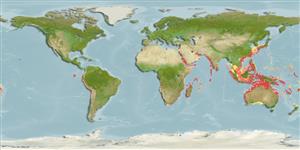Actinopterygii (ray-finned fishes) >
Tetraodontiformes (Puffers and filefishes) >
Diodontidae (Porcupinefishes (burrfishes))
Etymology: Cyclichthys: Greek, kyklos = round + Greek, ichthys = fish (Ref. 45335).
Environment / Climate / Range
Ecology
Marine; reef-associated; depth range 3 - 90 m (Ref. 30573). Tropical, preferred ?
Indo-West Pacific: Red Sea to South Africa and east to southern Japan, the Philippines, Australia and New Caledonia (Ref. 9680). Eastern Pacific: Galapagos Islands (Ref. 5227). Mediterranean: Israel (Ref. 43448).
Size / Weight / Age
Maturity: Lm ? range ? - ? cm
Max length : 34.0 cm TL male/unsexed; (Ref. 9710)
Found in coastal waters in the vicinity of reefs (Ref. 9680). Lives in seagrass habitats and coastal slopes with sponges. Active during the night (Ref. 48637). Nocturnal and solitary (Ref. 9680), usually found under ledges during the day (Ref. 9710). Juveniles pelagic (Ref. 30573). Feeds on hard-shelled invertebrates (Ref. 9680). Not usually marketed (Ref. 9680).
Life cycle and mating behavior
Maturity | Reproduction | Spawning | Eggs | Fecundity | Larvae
Leis, J.M., 1986. Diodontidae. p. 903-907. In M.M. Smith and P.C. Heemstra (eds.) Smiths' sea fishes. Springer-Verlag, Berlin. (Ref. 4423)
IUCN Red List Status (Ref. 115185)
CITES (Ref. 94142)
Not Evaluated
Threat to humans
Harmless
Human uses
Fisheries: of no interest
More information
Common namesSynonymsMetabolismPredatorsEcotoxicologyReproductionMaturitySpawningFecundityEggsEgg development
ReferencesAquacultureAquaculture profileStrainsGeneticsAllele frequenciesHeritabilityDiseasesProcessingMass conversion
Tools
Special reports
Download XML
Internet sources
Estimates of some properties based on models
Phylogenetic diversity index (Ref.
82805): PD
50 = 0.6250 [Uniqueness, from 0.5 = low to 2.0 = high].
Bayesian length-weight: a=0.03090 (0.01293 - 0.07384), b=2.89 (2.68 - 3.10), in cm Total Length, based on LWR estimates for this (Sub)family-body shape (Ref.
93245).
Trophic Level (Ref.
69278): 3.5 ±0.41 se; Based on food items.
Resilience (Ref.
69278): .
Vulnerability (Ref.
59153): Low vulnerability (18 of 100) .
